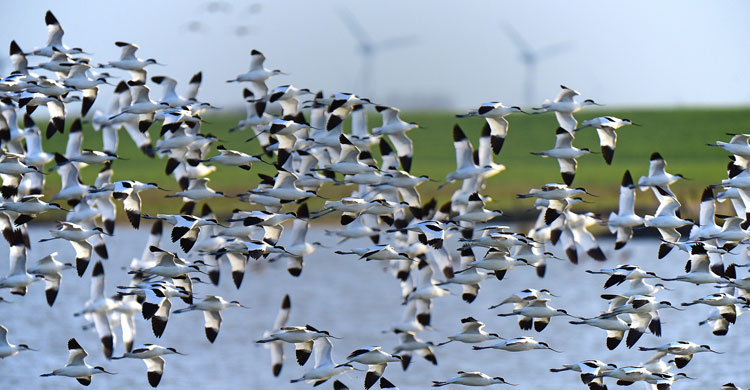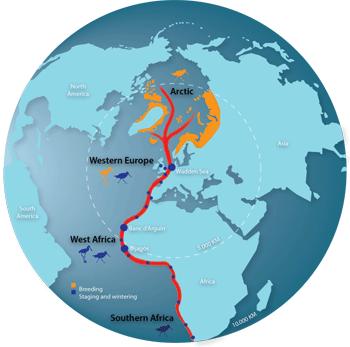Wadden Sea Day: Celebrating one of the Better Functioning Flyway Networks in the World

Piet Avocets (Recurvirostra avosetta) at the Wadden Sea © pixabay.com
Bonn, 31 August 2017 - August 31 is Wadden Sea Day, a celebration organized by the Common Wadden Sea Secretariat and the National Park Lower Saxon Wadden Sea and taking place at the UNESCO Wadden Sea World Heritage Visitor Centre in Wilhelmshaven. This year’s event focuses on “Partnering for World Heritage” and showcases examples of successful cooperation across sectors and borders from the Wadden Sea region and beyond.
The Wadden Sea is the largest unbroken system of intertidal sand- and mudflats in the world, with natural processes undisturbed throughout most of the area. The 1,143,403 ha World Heritage property encompasses a multitude of transitional zones between the land, the sea and freshwater environments, and is rich in species specially adapted to the demanding environmental conditions. It is considered one of the most important areas for migratory birds in the world, and is connected to a network covering other key sites. Its importance is not only in the context of the East Atlantic Flyway but also in the critical role it plays in the conservation of African-Eurasian migratory waterbirds.
Birds in the Wadden Sea - Global responsibility
The Wadden Sea is of outstanding international importance for migratory waders. According to the AEWA Critical Site Network and recognized by the Ramsar Convention the Wadden Sea is essential for the existence of at least 52 populations of 41 migratory waterbird species that use the East Atlantic Flyway and which originate from breeding populations as far away as northern Siberia and north-east Canada. The Wadden Sea represents a critical refueling stopover site allowing the birds to complete their journeys of thousands of kilometres. Every year more than 6.1 million birds may be present in the Wadden Sea at the same time, whilst on average 10 to 12 million birds use the Wadden Sea each year on migration between their northern breeding grounds and their wintering areas in Europe, Africa and even further afield.
In 2009 UNESCO placed the Dutch-German Wadden Sea on the World Heritage List recognizing the crucial importance of the site for the survival of migratory birds on a global scale. In 2014 the Danish Wadden Sea was added to the World Heritage Site. The three countries have now an enhanced responsibility to strengthen cooperation with other countries for the conservation of migratory birds, especially along the East Atlantic Flyway.
 Wadden Sea Flyway Initiative
Wadden Sea Flyway Initiative
The Wadden Sea Flyway Initiative has thus been launched to put this into action. In the first instance, two projects have been developed under the initiative that together aim to increase capacity for migratory bird conservation and monitoring along the western seaboard of Africa. The projects, which run from 2012 to 2015 will at least be continued until 2018 and are funded by the German Federal Ministry for the Environment and the Dutch Ministry of Economic Affairs, Agriculture and Innovation. The aims of the Wadden Sea Flyway Initiative are to support the conservation of migratory waterbirds in the region, to obtain more detailed monitoring data and to develop a long-term perspective for the cooperation of the Wadden Sea with countries along the whole flyway.
Trilateral Cooperation for the Protection of the Wadden Sea
The Wadden Sea Flyway Initiative is working in close collaboration with other migratory bird conservation projects and initiatives in West Africa, notably the BirdLife Conservation of Migratory Birds (CMB) project of BirdLife International funded by MAVA Foundation, implemented in collaboration with Wetlands International and other partners and the Agreement on the Conservation of African-Eurasian Migratory Waterbirds (AEWA). The Initiative aims for sustainable cooperation with partners and international projects along the whole East Atlantic Flyway by further enhancing and integrating the flyway perspective into the work plan of the Trilateral Wadden Sea Cooperation.
“Cooperation is crucial to preserve the site network along its entire extent. Without networking and cooperation between national governments, local authorities and communities, protected area managers and civil society along the flyway, conservation efforts would remain patchy and uncoordinated.”, says Sergey Dereliev.
“The network of sites along the East Atlantic Flyway of which the Wadden Sea is an integral part, is one of the better functioning networks in the world and can serve as an example for other ones. The coordinated conservation efforts are yielding results - the status of the migratory waterbird populations in the East Atlantic Flyway is relatively more favourable compared with other flyways in the Agreement area”, adds Sergey Dereliev.
In the same spirit of collaboration and need for networking, World Shorebirds Day will be celebrated on 6 September – a celebration of shorebirds and those protecting them. Based on the recognition that healthy populations of shorebirds depend on healthy wetlands - as do thousands of human lives around the world, one of the key aims of this day is to connect people with shorebirds through wetland sites around the world, for their better conservation.
Last updated on 06 September 2017


